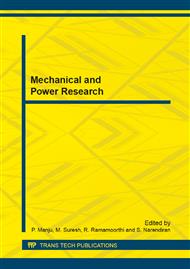[1]
S. Pickering, Compos. Appl. Sci. Manuf. 2006. 37, 1206.
Google Scholar
[2]
D.O. Kim, S.W. Keum, J.H. Lee, and J.D. Nam, Compos. Appl. Sci. Manuf. 2006 37, 2121.
Google Scholar
[3]
W.V. Paepegem, I.D. Baere, and J. Degrieck, Compos. Sci. Techn., 2006. 66, 1465.
Google Scholar
[4]
A.M. Beckry, Z. Saeed, G. Katrina, and S. Marcus, Compos. Struct., 2005. 71, 320.
Google Scholar
[5]
C.A. May and G.Y. Tanaka, Epoxy Resin Chemistry and Technology, Marcel Dekker, New York. (1973).
Google Scholar
[6]
R.S. Baur, Epoxy Resin Chemistry Advances in Chemistry, Vol. 114, American Chemistry Society, Washington, DC. (1979).
Google Scholar
[7]
W.G. Potter, Epoxide Resins, Springer-Verlag, New York. (1970).
Google Scholar
[8]
P.K. Mallick, Fiber Reinforced Composites, Marcel Dekker, New York . (1988).
Google Scholar
[9]
K. Dusek, Advances in Polymer Science, Springer-Verlag, Berlin. (1985).
Google Scholar
[10]
Ding C, Jia D, He H, Guo B and Hong H, Polym Test . 2005 24: 94.
Google Scholar
[11]
Ye YP, Chen HB, Wu JS, Ye L, Polymer . 2007. 48 6426.
Google Scholar
[12]
Deng S, Zhang J, Ye L, Wu JS, Polymer. 2008. 49 , 5119.
Google Scholar
[13]
Deng S, Zhang J, Ye L, Wu J. Toughening epoxies with halloysite nanotubes. Polymer. 2008 49: 5119-5127.
DOI: 10.1016/j.polymer.2008.09.027
Google Scholar
[14]
Ning Ny, Yin Qj, Luo F, Zhang Q, Du R, Fu Q. Crystallization behavior and mechanical properties of polypropylene/halloysite composites. Polymer . 2007. 48: 7374-7384.
DOI: 10.1016/j.polymer.2007.10.005
Google Scholar
[15]
Marney DCO, Russell LJ, Wu DY, Nguyen T, Cramm D, Rigopoulos N, Wright N, Greaves M. The suitability of halloysite nanotubes as a fire retardant for nylon 6. Polymer Degradation and Stability. 2008. 93: 1971-(1978).
DOI: 10.1016/j.polymdegradstab.2008.06.018
Google Scholar
[16]
Ye Y, Chen H, Wu J, Ye L. High impact strength epoxy nanocomposites with natural nanotubes. Polymer 2007; 48(21): 6426–33.
DOI: 10.1016/j.polymer.2007.08.035
Google Scholar
[17]
Deng S, Zhang J, Ye L, Wu J. Toughening epoxies with halloysite nanotubes. Polymer 2008; 49(23): 5119–27.
DOI: 10.1016/j.polymer.2008.09.027
Google Scholar
[18]
Kim J-K., Hu C., Woo R. S. C., Sham M-L.: Moisture barrier characteristics of organoclay-epoxy nanocomposites. Composites Science and Technology, 2005. 65, 805–813.
DOI: 10.1016/j.compscitech.2004.10.014
Google Scholar
[19]
Jones F. R.: Matrices: Epoxy resins. in Handbook of polymer-fibre composites, (eds.: Jones F. R. ) Polymer Science & Technology Series, Longman Scientific &Technical, England, 1994. 69–129.
Google Scholar
[20]
Kim JK, Hu C, Woo R, Sham ML. Moisture barrier characteristics of organoclay– epoxy nanocomposites. Compos Sci Technol 2005; 65: 805–13.
DOI: 10.1016/j.compscitech.2004.10.014
Google Scholar
[21]
Mohan TP, Kanny K. Water barrier properties of nanoclay filled sisal fibre reinforced epoxy composites. Compos Part A: Appl Sci Manuf 2011; 42(4): 385–93.
DOI: 10.1016/j.compositesa.2010.12.010
Google Scholar
[22]
Becker O, Varley RJ, Simon GP. Thermal stability and water uptake of high performance epoxy layered silicate nanocomposites. Euro Polym J 2004; 40: 187–95.
DOI: 10.1016/j.eurpolymj.2003.09.008
Google Scholar
[23]
Liu W, Hoa SV, Pugh M. Fracture toughness and water uptake of highperformance epoxy/nanoclay nanocomposites. Compos Sci Technol 2005; 65: 2364–73.
DOI: 10.1016/j.compscitech.2005.06.007
Google Scholar
[24]
Zhao H, Li RKY. Effect of water absorption on the mechanical and dielectric properties of nano-alumina filled epoxy nanocomposites. Compos: Part A 2008; 39: 602–11.
DOI: 10.1016/j.compositesa.2007.07.006
Google Scholar
[25]
Liu YL, Wei WL, Hsu KY, Ho WH. Thermal stability of epoxy-silica hybridmaterials by thermogravimetric analysis. Thermochim Acta 2004; 412(1e2): 139e47.
Google Scholar
[26]
Tarrío-Saavedra J, López-Beceiro J, Naya S, Artiaga R. Effect of silica content on thermal stability of fumed silica/epoxy composites. Polym Degrad Stab 2008; 93(12): 2133e7.
DOI: 10.1016/j.polymdegradstab.2008.08.006
Google Scholar


